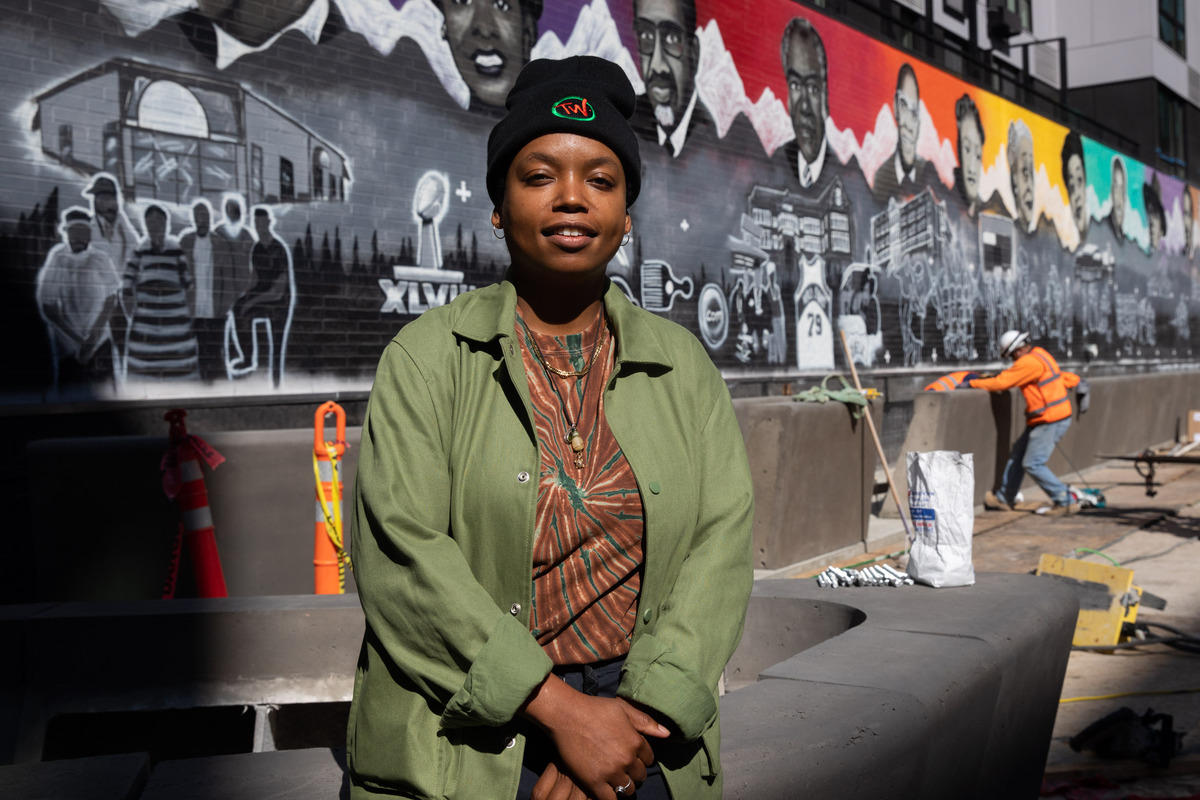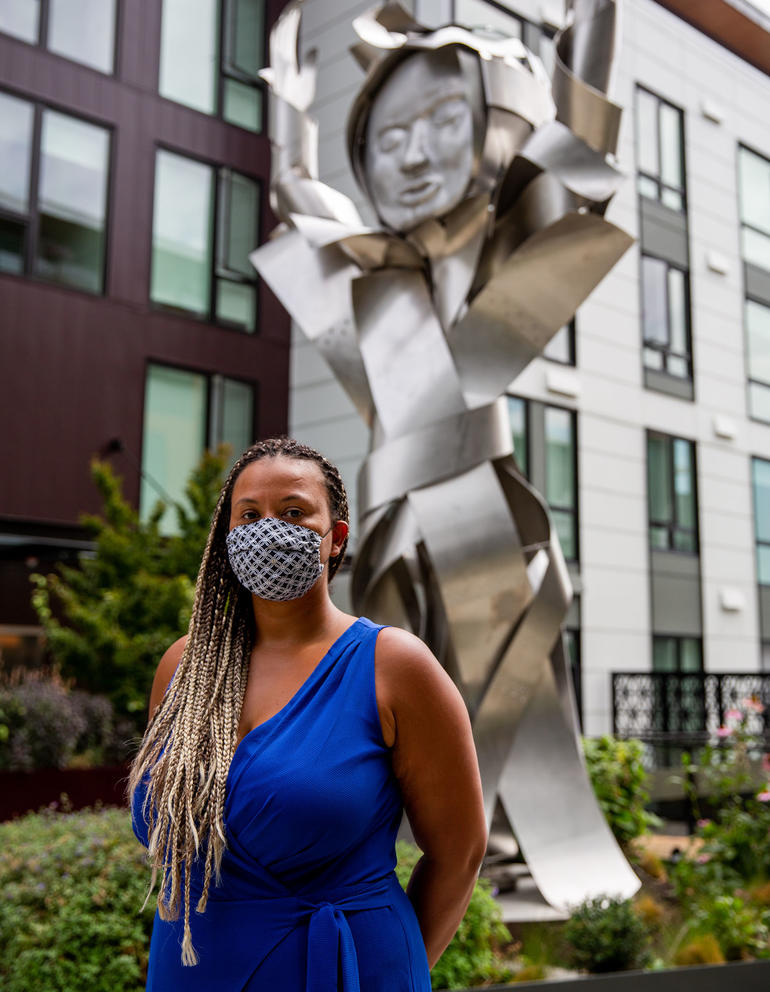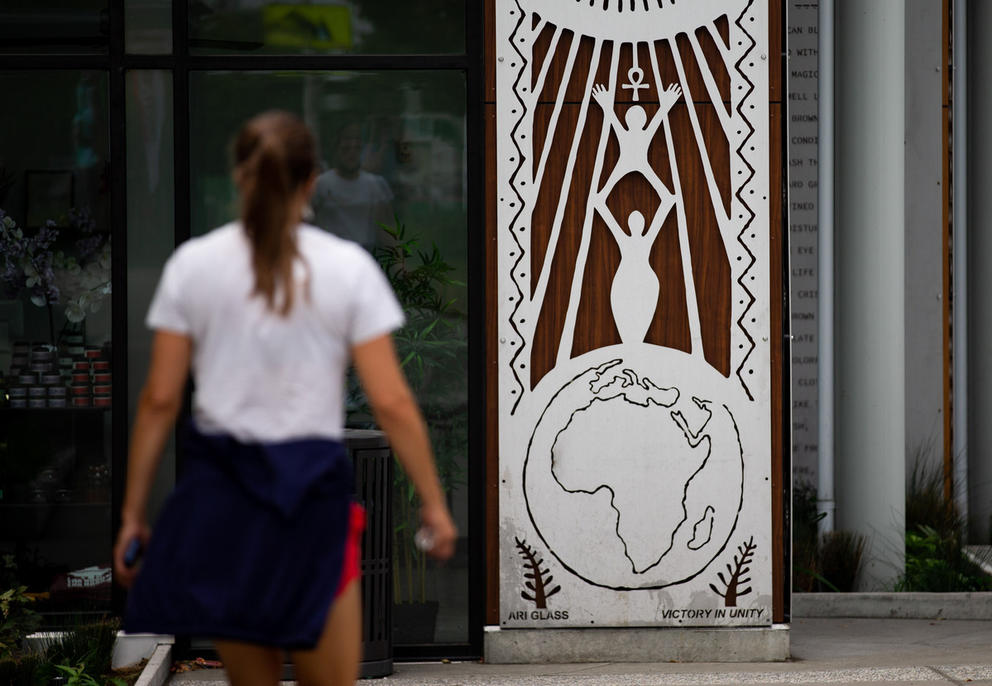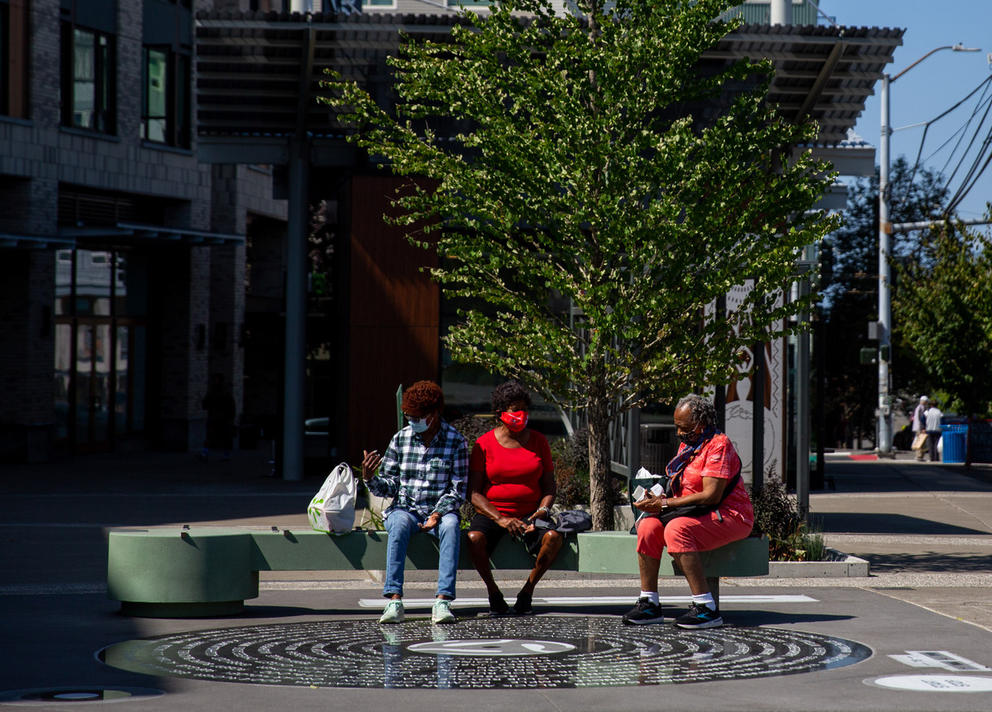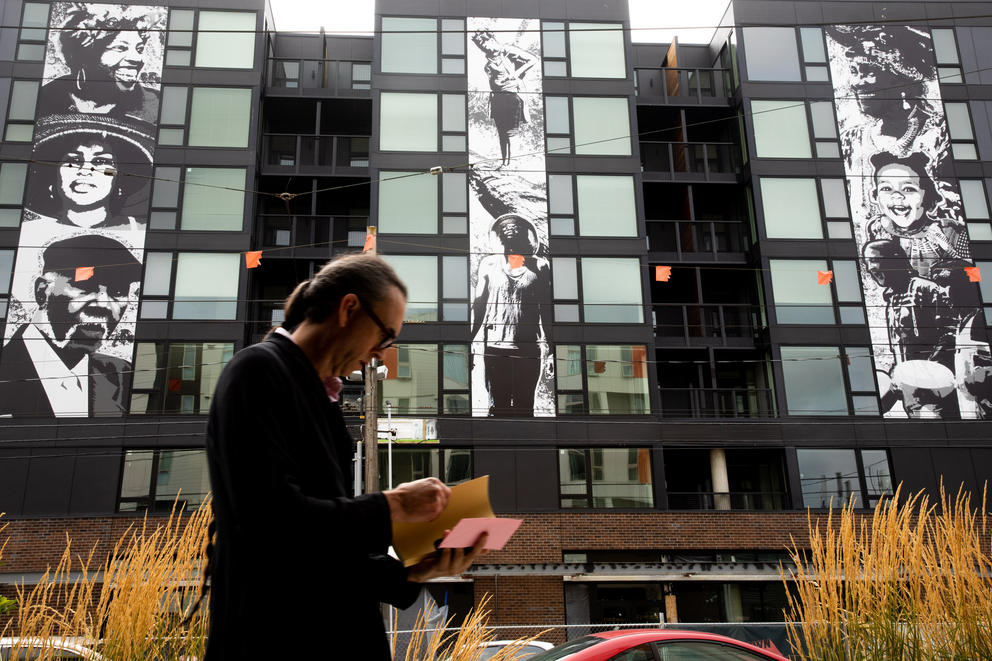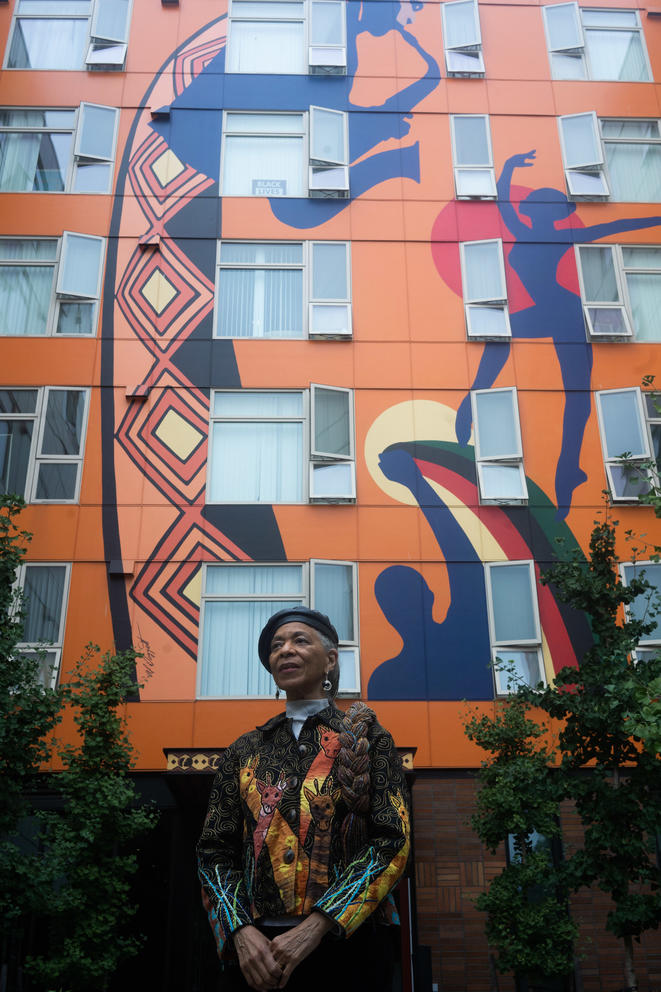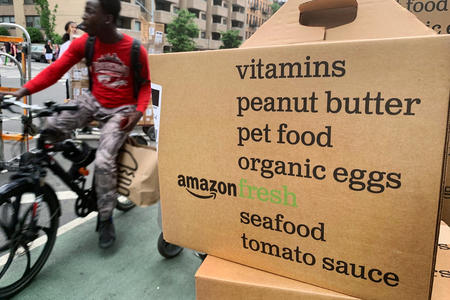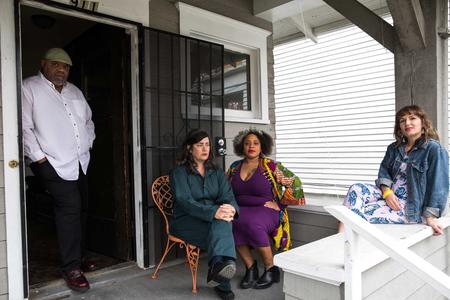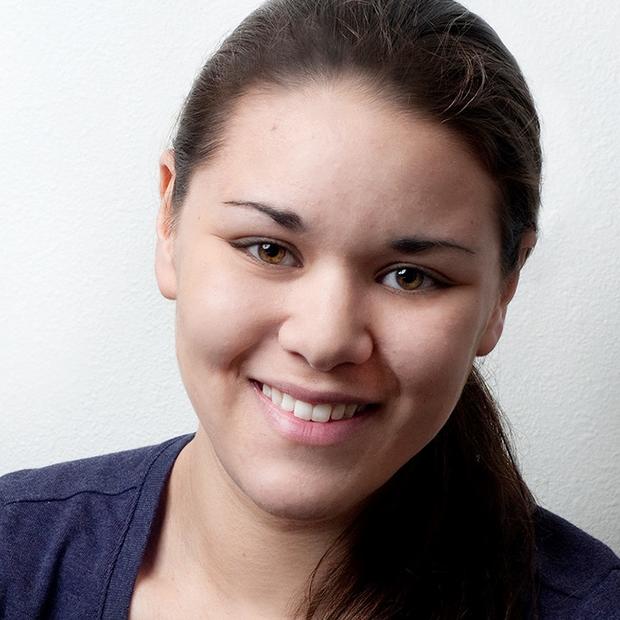African Black soap
Mixed with
Blue Magic
...
Deep conditioning shampoo
To wash the
Collard greens
Unrefined shea butter
To moisturize my
Black eye peas
Hung among seven other panels on the side of a newly built pavilion (housing a plant shop and a Black beauty store), the poem is an elegy for the businesses that once lined this historic intersection: the beloved Red Apple grocery store, a Black hair salon and African food mart, among others. Johnson calls it “a visual memory through words.”
“A lot of the imagery in the poem resonates with people who remember the space,” Johnson says. “I hope it feels like a hug.”
Memories are all that remain of the Red Apple and shopping center of yore. A 35,000-square-foot Amazon Fresh store, just a few steps from the engraved poem, has taken up residence in Jackson Apartments, a new seven-story, 532-unit development by Vulcan Real Estate, the late Paul Allen’s firm. Long before it was built, the controversial project had become a symbol (and benchmark) of the gentrification of the Central District, Seattle’s historically Black neighborhood.
“NOW LEASING” a large banner on the building’s rooftop blares on a recent day. With rentals averaging between $1,093 (a studio) to $2,898 (a three-bedroom), the complex lists a “fitness center,” “co-working lounge,” “dog spaw” and “on demand package delivery service” among its amenities. (20% of the units are affordable housing for households earning 65% to 90% of the Area Median Income.)
Also included: an onsite art collection, courtesy of local Black artists, many of whom — like Johnson — have ties to the neighborhood.
The Jackson Apartments “art walk” is part of a current wave of Central District developments that boast a trove of site-specific, semipublic art commissions by local Black artists, meant to honor the neighborhood’s history and cultural vibrancy.
“Having a visual presence and having a place here is … very critical to keeping the spirit of what was once here alive,” says Leilani Lewis, public art consultant on the Jackson project, during a recent tour of the art. At the end of a (public) pedestrian corridor slicing through the property, we are greeted by a towering figure: a sculpture called “Winds of Change: We Are Still Here,” by local artists Marita Dingus and Preston Hampton. A female figure made from a twisted bouquet of stainless steel plates spreads out her arms, furrows her brow and closes her eyes in concentration.
“The name of this particular goddess is Oya,” Lewis says, after the Yoruba orisha, or deity, of storms. She is a protector but also the holder of change, wrestling with forces bigger than herself, Lewis notes. “A not so veiled reference to the change [in] the community,” she says.
That change is happening at this very moment: a dozen or so blocks north, at 23rd Avenue and East Union Street, another large-scale development — Midtown Square — is installing 8 artworks by local artists that (in some cases) literally wrap the building’s facade. Nearby, the affordable housing development Africatown Plaza — which has yet to break ground — is commissioning 20 artists for a permanent art collection “focused on healing, restoring, and celebrating Black and Pan-African communities in the Central District,” says the development’s website. And on the western edge of the CD, near 12th Avenue and East Yesler Way, the developer behind another large-scale project has just commissioned a swath of artworks by a group of respected artists who are local, Black, Indigenous or people of color to represent the neighborhood’s current and historic communities.
This is not a coincidence, but the result of years of advocacy by neighborhood groups like the Historic Central Area Arts & Culture District, Africatown and others who have pressured developers to preserve the neighborhood’s Black culture.
“Over and over again the community has communicated that ‘we are still here.’ I think that message is being heard and responded to,” says longtime Seattle arts leader Vivian Phillips, who played an instrumental role in some of this advocacy work as a co-founder of the Historic Central Area Arts & Cultural District.
Also responsible for the advent of new art: Central District-specific design guidelines, particularly a set of instructions specifying that new developments in designated zones (“cultural anchors” like 23rd and Jackson and 23rd and Union) should incorporate public art that references the history, heritage and culture of the community and neighborhood.
These recommendations — part of a strategy by the city and neighborhood advocates to respond to displacement concerns and make development more reflective of the community’s history and priorities — went into effect in 2018, along with a new public design review board specific to the Central District that makes sure the guidelines are implemented.
While not exactly an ace in the hole, these guidelines give this city-appointed board some power, as developers can’t get the necessary permits from the city’s Department of Construction & Inspections without the board’s approval. To put it simply: If a major project doesn’t have a neighborhood-specific art plan with community buy-in, chances are slim it gets built.
Project curator Leilani Lewis, also the Director of Diversity, Equity and Inclusion for the Advancement organization at the University of Washington, stands for a portrait next to “Winds of Change: We Are Still Here,” a stainless steel and aluminum sculpture by Marita Dingus and Preston Hampton at Jackson Apartments, a new development. (Lindsey Wasson for Crosscut)
‘We are still here’
Regardless of the rules, art — and the cultural cachet and attention it brings — can sometimes increase the value of developments. Real estate developers capitalizing on artists’ cultural status to brand or market their developments, or generally to improve their reputation, is often called “art washing.” Phillips, who was involved with the Jackson Apartments and Midtown Square developments, doesn’t see it as necessarily that way.
“My experience has been that developers have used art to both respond to community requests and to enhance the place-making experience. That is not to say that there aren’t probably developers out there that are doing [art washing], it just has not been my experience,” she says. “It doesn't hurt that the Design Review panels are also placing more requirements on developers to be respectful of and responsive to community desires,” she adds.
Phillips is well aware that new installations by Black artists won’t reverse gentrification. But, she says, “I had this recognition a number of years ago that, while I couldn’t change the direction that things were going, maybe I could be a part of how the path was charted,” she says. Since then, she has served as an art consultant on a variety of projects for developers. “Having the opportunity to bring so many Black artists into these projects, where they probably would not have had other opportunities of that magnitude? I feel good about that.”
It also sends an important signal, she says. “With the severe reduction of Black residents in the Central Area, part of what this represents is that we were here, and we are still here, and we will be here, in some form. We’re making our mark … through art, to make sure that people cannot forget or erase us.”
Phillips, who grew up in the neighborhood and today lives just blocks from 23rd Avenue and South Jackson Street, knows firsthand the power art has to make her feel at home. There are days she feels like an “endangered species” in the neighborhood. But seeing Ernestine Anderson Way, or the art on 23rd and Jackson, “reminds me that I am in a community that once flourished with people like me. It makes me feel a little bit more [mentally] safe,” she says, “and remember that I am not a foreigner in a strange land.”
Reversing gentrification
In the span of a few decades, the Central District’s demographic makeup and built environment has completely transformed. The neighborhood became a hub for the Black community (as well as Jewish and Asian communities) around the turn of the 19th century, and it stayed that way by design. For decades, many Black families and other people of color essentially couldn’t live anywhere else because of segregation in the form of racist housing covenants restricting residency to white people, redlining in the lending industry and other discriminatory practices.
Displacement, fueled by rapid development, aggressive real estate targeting practices, the economic crisis and urban renewal policies, has shrunk the Central District’s Black population — which was 73% in 1973, according to city data — down to just under 25% in 2010.
Data from the recently released 2020 census show that the Central District’s Black population has further shrunk, to about 16%, even as some residents have been able to come back to the neighborhood, thanks to affirmative marketing, community preference and other anti-displacement tools meant to “reverse gentrification.”
Vulcan and Amazon have long been the (for many, unwelcome) face of the neighborhood’s transformation, particularly among artists. In 2017, a coalition of artists called on Vulcan to “put their money where their mouth is” and set aside a portion of the market-rate housing at 23rd and Jackson for lower-income artists making 30% to 50% of the average median income. (Vulcan did not include such units in the project.)
Elisheba Johnson says she had some initial misgivings about participating in a Vulcan development project. “It’s complicated. I had somebody in the community tell me not to make the artwork, because they didn’t approve of Vulcan going in and creating apartments in that space,” she says. “My argument was kind of: ‘the building is going up whether or not we like it. But here’s an opportunity for you to have an impact on the space and the environment.’ ”
However, if the amount of Black art represented in the neighborhood is inversely proportional to its Black population, who is this art for? “There’s just a bigger conversation about … when we make culturally relevant art for a community that is priced out of the neighborhood,” Johnson says.
Nonetheless, she adds: Black people are still here. Some live here and many come here to shop, attend events, dine out and witness art. Consider the longtime Central Area businesses — like Catfish Corner and Earl’s Cuts & Styles — coming back to the neighborhood, rehoused in new developments. Or Wa Na Wari, the Central District art and community space Johnson co-founded. “People still want to be in this neighborhood,” Johnson says. “They want to reclaim space.”
A turning point
On a recent summer day on the plaza in front of the Jackson Apartments, three older Black women took a break from grocery shopping and chatted as they sat on a mint-green bench in the shape of a record player tonearm. Part of a public artwork by Paul Rucker titled “78 on Jackson,” the 2,800-pound arm is affixed to an oversized turntable embedded in the concrete of the plaza, complete with a 12-foot-wide granite “vinyl” record. Etched in the granite, like grooves, are the names of 70 jazz artists — saxophonist Tootie Boyd, pianist Patti Bown and needs-no-introduction Quincy Jones — and 32 venues that once lined Jackson Street (where Rucker himself once had his studio before being forced to move to White Center after the building sold).
“[Rucker] wanted to invoke and remember the names of the people and the places that made Jackson, this corridor, very active and alive,” Lewis says. “The neighborhood had a booming jazz scene in the 1920s and 1930s.”
In 2016, when news broke that Vulcan would make a foray into the Central Area, it felt like a record scratch. Tensions were already running high. As large-scale development picked up speed and the gentrification of the neighborhood seemed to be reaching a boiling point, the Jackson project proved a tipping point and catalyst for neighborhood groups to start pushing back and demanding a say in the neighborhood’s built environment.
The resulting design guidelines didn’t end up coming into play for Vulcan’s Jackson project (which rerouted 0.5% of its building costs toward the art, per its usual policy), but the guidelines did apply to another major — and controversial — project: Midtown Square, on 23rd and Union.
In 2018, that project, by Lake Union Partners, was sent back into design review because the art plan didn’t pass muster.
The Midtown Square developers engaged an advisory board made up of local arts leaders (including Leilani Lewis) which, with the help of Vivian Phillips, artist Aramis O. Hamer and architect Rico Quirindongo, selected eight local artists for commissions totaling $225,000.
To advocates, this extensive art plan is evidence that the new rules are working. Many point to the three other buildings by Lake Union Partners built earlier around the same intersection, none of which have public art. “If it weren’t for the design review process, [Midtown Square] would be just another building skin,” says Jeffrey Floor, a member of the Central Area Design Review Board.
Now, the Midtown website boasts “one of the largest privately run public arts projects in the PNW region.” Local artist Henry Jackson-Spieker (in collaboration with KT Hancock) will highlight that history with an installation of lanterns featuring the images of local musicians and artists suspended above the pedestrian thoroughfare. Nearby, Takiyah Ward (who coordinated the Black Lives Matter mural on Capitol Hill) is painting a colorful, 120-foot-long mural depicting a visual timeline of the history of the neighborhood and the people who made it great, Ward says, including early Seattle settler and businessman William Grose, influential Seattle art dealer Zoe Dusanne and Rev. Dr. Samuel B. McKinney.
A pedestrian walks past a triptych titled “The Hopeful,” by local visual journalist and artist Adam Jabari, on top of the Midtown building. “I find it really ... inspiring to be able to walk around a neighborhood and see representation of people who look like me,” Jabari says. “Right around home.” (Matt M. McKnight/Crosscut)
Adam Jabari, a local visual journalist and artist, opted to depict local community members, of whom he snapped photos during various local events over the past years. Now, they’re plastered all over the building’s exterior walls in the form of 44-foot tall, black-and-white murals made on Hardie panels. “It’s meant to be us: the people of the Central District,” says Jabari, who frequents Earl’s Cuts & Styles across the street and lives about a mile north of the building. “I see that as a more universal Black and brown [community].”
On the same block, in a mural wrapping around the building’s 23rd and Union corner, Barry Johnson opted for what can only be called the dazzling opposite of Jabari’s bold duotone: multicolored squares, lines and trapezoids that bump into and tumble over each other like a Jackson Street “Boogie Woogie.”
Artist Barry Johnson at the intersection of 23rd and Union in Seattle’s Central District, across the street from the Midtown Square building where his jazz-inspired work is installed on the facade. Johnson started studying architecture a year and a half ago. “It’s got me rethinking site activation,” he says. (Matt M. McKnight/Crosscut)
“It’s high-contrast sampling,” Johnson told me on a recent spring day, as construction workers in hard hats bolted the panels one by one onto the facade. It’s an homage to the improvisational nature of jazz, inspired in part by Jacob Lawrence’s piercing use of color. “A lot of traditional architecture and all the buildings now use these really interesting, low-contrast, muted colors,” Johnson says. “I wanted to throw some fuchsia, some teal, some yellow in there…. I wanted something that as you're driving by, it just pulls you — it’s undeniable.”
Afrocentric design
Just to the south of Midtown Square, on the same block, sits a lot filled with construction material. In four years, a 130-unit affordable housing building will rise up here. The influence of African design will be evident through textures and undulating patterns, as well as plant species from Africa. The lot became Africatown’s to develop (in partnership with Community Roots Housing) when Lake Union Partners sold 20% of its larger parcel to Africatown Community Land Trust and local nonprofit Forterra for $4.5 million. (Forterra later transferred its interest to Community Roots Housing.)
The guiding principle for the design and art plan, says Wyking Garrett of Africatown, is Sankofa, “Which is to look back, and, going forward, to honor the past and build a future that continues,” he says. “The Black community has called the Central District home for almost 140 years, has faced so many institutional and systemic barriers towards being able to grow and thrive, but still has been that proverbial rose growing through concrete,” he says. Africatown Plaza’s art philosophy is simple: to lift up the “beauty, the brilliance and the best of the Black experiences,” Garrett says.
“Part of that is also supporting artists from our community that are often overlooked due to inequities in the art world,” he adds.
Lisa Myers Bulmash created intricately layered mixed-media collages for a community room at the Liberty Bank Building. The work (made of books, newspaper clippings, photos and vintage “kiss lock” purses) tells the history of the Liberty Bank through personal stories of the founders and architects. Embedded in the books are photos of the Statue of Liberty as it was being built, to convey “the idea that liberty, whether its financial or political liberty, is always a work in progress,” Bulmash says. (Matt M. McKnight/Crosscut)
The Africatown Plaza development is meant to build on the success of the Liberty Bank building — the affordable housing complex that was built on the site of and named after the first Black-owned bank west of the Mississippi — and opened its doors in 2019. A collaboration between Africatown, the Black Community Impact Alliance, Community Roots Housing and Byrd Barr Place, the project is widely considered a triumph and leading example of what “inclusive development” can look like.
Plans for the building (which houses Earl’s Cuts & Styles and Communion restaurant on the ground floor) were greenlit before the Central District design guidelines were in place. The extensive art plan was fueled by pressure and activism from Africatown, the Central Area Land Use Review Committee and other local groups to honor its historical location and reflect the neighborhood.
Co-curators and longtime local artists Esther Ervin and Al Doggett carefully designed the building’s art plan and selected seven other local artists, including Lisa Myers Bulmash, Inye Wokoma and Aramis O. Hamer to create artwork for the building’s lobby and community rooms. Doggett devised the bright orange mural on the building’s exterior and Ervin designed a bronze water feature of salmon swimming upstream, as well as round “drum benches,” which are embellished with a colorful mosaic and have wooden tops inspired by African basket weave patterns.
Art is powerful, Garrett says: it can heal, create a sense of place. For Africatown, art is part of a larger community development strategy to bring the community back to the neighborhood. But, he notes, it is paired with the nonprofit’s effort to create permanent affordable housing and commercial space for Black people and businesses. If that isn’t in place, it’s just dress-up.
“What we don’t want to see is people just tokenizing our experiences in ways that just are superficial,” Garrett says. “We don't want to put a face on the same kind of economic practices again, and become just museum pieces ... plaques, murals or statues,” he says. “We don’t want to just see our images on the outside — we also want to be on the inside of the spaces.”
Artist Lisa Myers Bulmash, who made artwork for the community room at the Liberty Bank Building (and will create art for a future development on 12th and Yesler) says she hopes newcomers to the area are aware that they’re entering into a really special place. “You bought your house, you bought your condo. But this place had history before you showed up.” (Matt M. McKnight/Crosscut)
Get the latest in local arts and culture
This weekly newsletter brings arts news and cultural events straight to your inbox.

